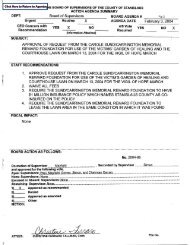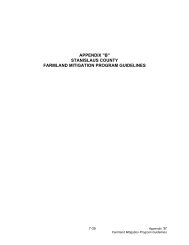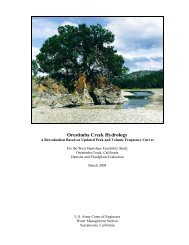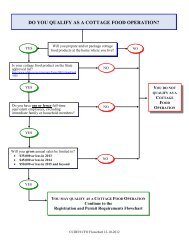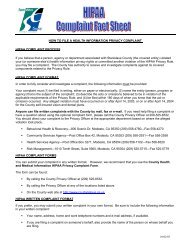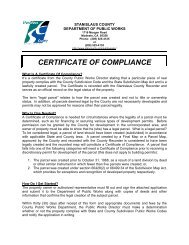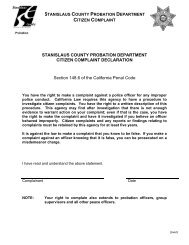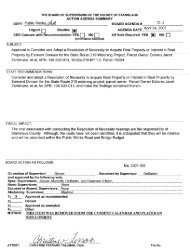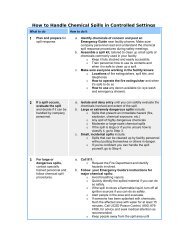Orestimba Creek Feasibility Study - Stanislaus County
Orestimba Creek Feasibility Study - Stanislaus County
Orestimba Creek Feasibility Study - Stanislaus County
You also want an ePaper? Increase the reach of your titles
YUMPU automatically turns print PDFs into web optimized ePapers that Google loves.
Economics Appendix – Draft Report - <strong>Orestimba</strong> <strong>Creek</strong> <strong>Feasibility</strong> <strong>Study</strong>, <strong>Stanislaus</strong> <strong>County</strong>, California – September 2012<br />
Residential property: Rural/urban Rural residents may be more vulnerable due to lower incomes<br />
and more dependent on locally based resource extraction economies (e.g., farming, fishing).<br />
High-density areas (urban) complicate evacuation out of harm’s way.<br />
Residential property: The value, quality, and density of residential construction affects potential<br />
losses and recovery. Expensive homes on the coast are costly to replace; mobile homes are easily<br />
destroyed and less resilient to hazards.<br />
Infrastructure and lifelines: Loss of sewers, bridges, water, communications, and transportation<br />
infrastructure compounds potential disaster losses. The loss of infrastructure may place an<br />
insurmountable financial burden on smaller communities that lack the financial resources to<br />
rebuild.<br />
Renters: People that rent do so because they are either transient or do not have the financial<br />
resources for home ownership. They often lack access to information about financial aid during<br />
recovery. In the most extreme cases, renters lack sufficient shelter options when lodging<br />
becomes uninhabitable or too costly to afford.<br />
Occupation: Some occupations, especially those involving resource extraction, may be severely<br />
impacted by a hazard event. Self-employed fisherman suffer when their means of production is<br />
lost and may not have the requisite capital to resume work<br />
in a timely fashion and thus will seek alternative employment. Those migrant workers engaged<br />
in agriculture and low skilled service jobs (housekeeping, childcare, and gardening) may<br />
similarly suffer, as disposable income fades and the need for services declines. Immigration<br />
status also affects occupational recovery.<br />
Family structure: Families with large numbers of dependents or single-parent households often<br />
have limited finances to outsource care for dependents, and thus must juggle work<br />
responsibilities and care for family members. All affect the resilience to and<br />
recovery from hazards.<br />
Education: Education is linked to socioeconomic status, with higher educational attainment<br />
resulting in greater lifetime earnings. Lower education constrains the ability to understand<br />
warning information and access to recovery information.<br />
Population growth: Counties experiencing rapid growth lack available quality housing, and the<br />
social services network may not have had time to adjust to increased populations. New migrants<br />
may not speak the language and not be familiar with bureaucracies for obtaining relief or<br />
recovery information, all of which increase vulnerability.<br />
Medical services: Health care providers, including physicians, nursing homes, and hospitals, are<br />
important post-event sources of relief. The lack of proximate medical services will lengthen<br />
immediate relief and result in longer recovery from disasters. Census data for 2010 indicate that<br />
there are 66 residents in nursing homes in Newman.<br />
99




